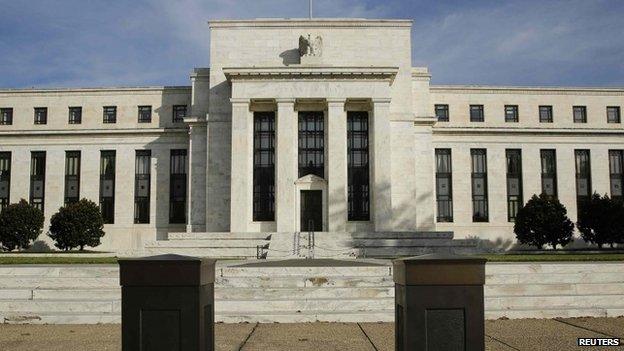End of QE is whimper not bang
- Published
- comments

The US Federal began "tapering off" its monthly bond buying programme in January
As the Fed Reserve ends quantitative easing, those who prophesied that these trillions of dollars of debt purchases would spark uncontrollable inflation have been proved wrong. But QE could still prove toxic.
The most striking thing about quantitative easing (QE), the unprecedented massive purchases of debt by the central banks of the big rich developed countries, and especially by the US Federal Reserve, is how anti-climactic it has all been.
When QE started at the end of 2008, many were the voices warning that the economy of the world was heading into dangerous uncharted territory.
Confidence in the credibility of the dollar and sterling would surely be shattered. Inflation would take off - and, whisper it softly, we could even find ourselves facing 1920s-style hyperinflation.
Well, on the day the US Federal Reserve brings to a close this intriguing chapter in the long and not always distinguished history of central banking, by ceasing its exceptional purchases of bonds, it may be fair to say that QE has all been a bit dull - or 50 shades of grey, without any sex.
The proponents of QE will say that without QE, the US and UK economies would have been even weaker than they would otherwise have been - and we might have experienced pernicious deflation, or intractable falling prices that would have provided businesses and households with a powerful incentive to defer purchases, and thus would have turned recession into vicious depression.
Boosted assets
And in encouraging investors to take the cash they received from central banks in the rich stagnating West and pump it into higher-return bonds and assets in emerging economies, maybe global growth received a bit of a fillip.
But proving any counterfactual in the complex system that is the global economy is well nigh impossible. We simply don't know the precise impact of the Fed having bought, since the end of 2008, about $3.5 trillion of US government debt and bonds created out of home loans or mortgages.
That said. we have probably learned two things.
First, that if there has been inflation, it has been in asset prices, rather than in items of everyday consumer expenditure.
The market price of the purchased bonds has been increased. And investors who received all those hundreds of billions of dollars from the Fed, pumped that money into shares and property and even the bonds of other countries, from India to Canada.
Now some of that effect was wanted and desired by the Fed. By increasing demand for bonds created out of mortgages, for example, the Fed encouraged the supply of homeloans and cut their prices - thus sparking a revival in the US housing market, a market so desperately important to consumer confidence and the strength of the American economy.
And by boosting share prices, the cost of capital was cut for businesses, and should have stimulated investment by them - although what has been profoundly depressing, some would say, is the extent to which businesses have continued to buy and cancel their own shares, even when capital is so cheap, rather than investing in expanded productive capacity.
So some of this rise in asset prices was probably not benign.
A part of it may be a bubble, waiting to be pricked - as and when, hypothetically speaking, investors started to fear that governments or households would struggle to ever repay debts, if economic growth in the long term turned out to be very anaemic.
Because what has been really striking about QE is that it was popularly dubbed as money creation, but it hasn't really been that.
If it had been proper money creation, with cash going into the pockets of people or the coffers of businesses, it might have sparked serious and substantial increases in economic activity, which would have led to much bigger investment in real productive capital.
And in those circumstances, the underlying growth rate of the UK and US economies might have increased meaningfully.
But in today's economy, especially in the UK and Europe, money creation is much more about how much commercial banks lend than how many bonds are bought from investors by central banks.
The connection between QE and either the supply of bank credit or the demand for bank credit is tenuous.
That is not to say there is no connection. But the evidence of the UK, for example, is that £375bn of quantitative easing did nothing to stop banks shrinking their balance sheets: banks had a too-powerful incentive to shrink and strengthen themselves after the great crash of 2008; businesses and consumers were too fed up to borrow, even with the stimulus of cheap credit.
The rebuilding of the credit-creation machinery may have been helped in the US by QE - which provided a more benign markets backdrop for the painful process of consumers writing off excessive debts and banks taking the associated huge losses.
That is one important reason why the US economy has grown more strongly since the debacle of 2008 than the UK's - where there has been no comparable reduction in the absolute size of household debts.
But the fundamental problem with QE is that the money created by central banks leaked out all over the place, and ended up having all sorts of unexpected and unwanted effects.
When launched it was billed as a big, bold and imaginative way of restarting the global economy after the 2008 crash.
It probably helped prevent the Great Recession being deeper and longer.
But by inflating the price of assets beyond what could be justified by the underlying strength of the economy, it may sown the seeds of the next great markets disaster.